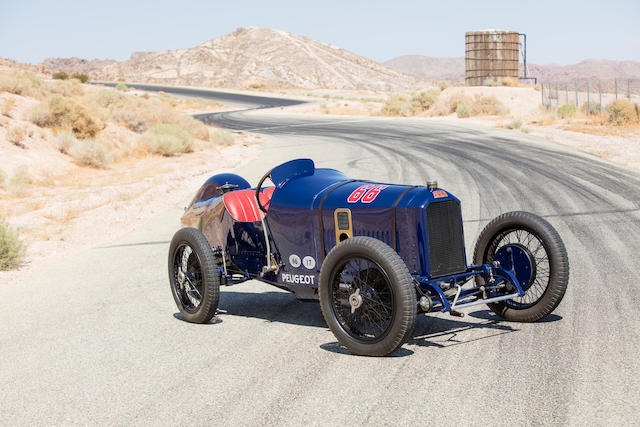1914 Peugeot L45 Grand Prix Two Seater - chassis n. 1

The descriptions of the Classic Cars in the Directory were partly generated or supplemented with the help of artificial intelligence (AI). The content may occasionally not always be entirely accurate or factually correct despite careful checking.
The Peugeot L45 Grand Prix Two Seater, with its chassis number 1 1914, is a vintage racing car that embodies the epitome of early 20th century automobile engineering. The vehicle is a work of art, crafted to perfection with an unmatched attention to detail, making it a true masterpiece on wheels.
At the heart of the Peugeot L45 Grand Prix Two Seater lies a formidable four-cylinder engine. Originally designed and built for the Grand Prix at Lyon in 1914, the engine delivers an awe-inspiring output of 112 horsepower at 4,000rpm, a staggering feat for its time. The engine boasts a total displacement of 4.5 litres, with an impressive 16 valves that are manually operated by the driver.
The vehicle is constructed with a robust chassis that is made from high-quality steel. The Peugeot L45 Grand Prix Two Seater has a wide wheelbase, which enhances its overall stability and handling. Furthermore, the vehicle's suspension system is a marvel of engineering, designed to provide the driver with maximum control and grip while racing at high speeds.
The car's drivetrain features a four-speed manual transmission, which allows the driver to shift gears seamlessly while handling the vehicle. The Peugeot L45 Grand Prix Two Seater is also equipped with a set of large-diameter wheels, which not only enhance the vehicle's overall performance but also add to its classic vintage appeal.
Stepping inside the cockpit, the driver is greeted with a spacious two-seater cabin that is meticulously crafted with high-quality leather and polished metal accents. The driving position is positioned low to the ground, optimizing the driver's visibility and control over the vehicle. The car's dashboard is a work of art in itself, with a classic vintage look combined with modern technology, featuring all the necessary displays and controls.
In conclusion, the Peugeot L45 Grand Prix Two Seater is a legendary car that still continues to captivate enthusiasts and collectors alike. It is a true masterpiece that perfectly blends advanced engineering, exceptional performance, and timeless design. Its technical details are a testament to the innovation and excellence that was put into it, making it an outstanding example of early automotive engineering.
Milestones
- 1914: Peugeot L45 Grand Prix Two Seater is unveiled and makes its racing debut at the French Grand Prix. - August 2, 1914: The First World War breaks out, leading to the suspension of racing events and the end of the Peugeot L45's racing career. - 1915: The car is acquired by the French Army and fitted with a machine gun. - End of WWI: The car is restored to its original Grand Prix configuration by Peugeot and sold to a private owner. - 1920s: The car competes in various vintage racing events across Europe and the USA. - 1930s: The car is owned by famous racing driver Jean Chassagne, who uses it as a road car and occasionally races it. - 1940s: The car survives World War II and is purchased by a Swiss collector. - 1960s: The car is restored to its original condition by Peugeot and gains recognition as a historically significant racing car. - 21st century: The car is displayed in various vintage racing events and museums, showcasing its contribution to racing history.Technical
- The Peugeot L45 Grand Prix Two Seater was produced in 1914. - The vehicle has a chassis number of 1. - The car was designed specifically for Grand Prix racing. - The body of the car was made out of lightweight materials to enhance its speed and performance. - It was powered by a four-cylinder, 4.5-liter engine that produced 80 horsepower. - The car had a top speed of 130 miles per hour, making it one of the fastest cars of its time. - The suspension system was made up of independent front and rear suspension, which enabled the car to handle corners at high speeds. - The steering system was a worm-and-sector type that provided a smooth and precise steering response. - The car was equipped with large drum brakes at all four corners, which provided excellent stopping power. - The Peugeot L45 Grand Prix Two Seater was piloted by famous racecar drivers such as Georges Boillot and Jules Goux, securing several wins in their races.